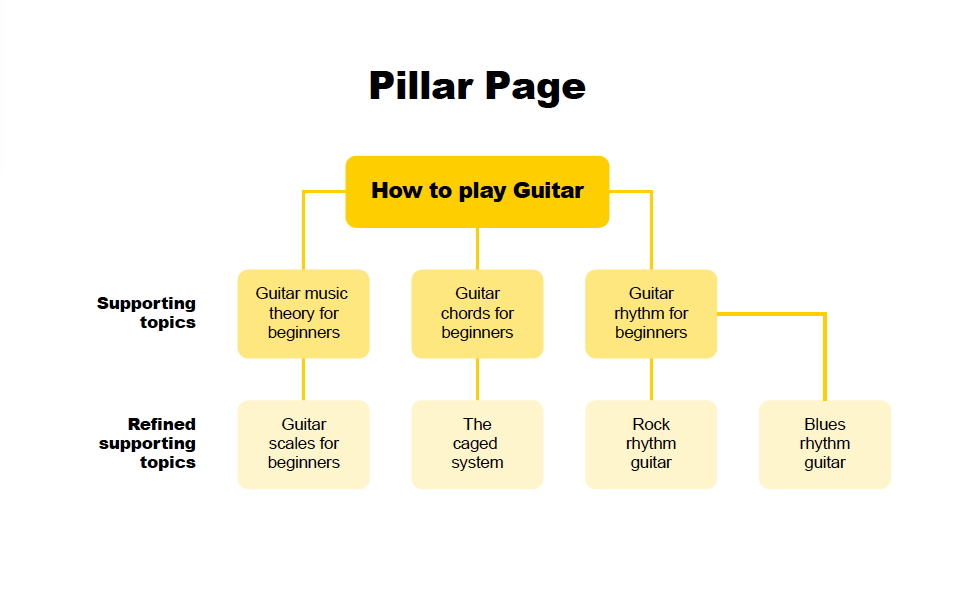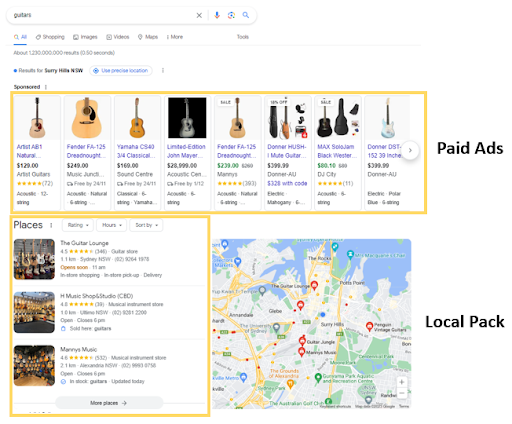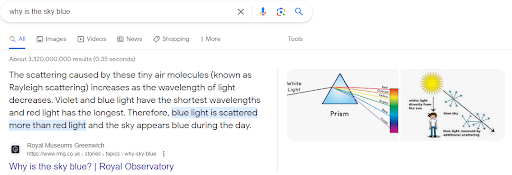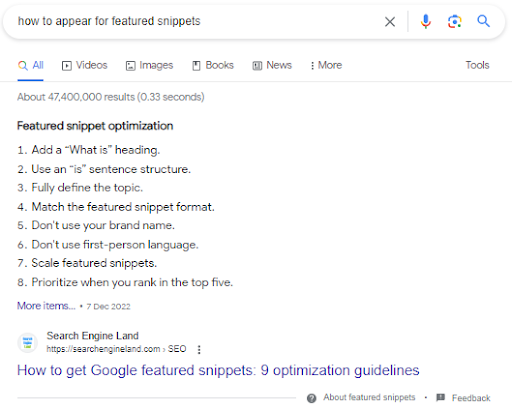Keeping up with the ever-changing landscape of SEO is crucial to your business’ online presence, ensuring you continue to attract new customers and grow your business both online and off.
To help you stay ahead of the curve, here are 6 critical SEO trends you need to embrace in 2024.
1. Topic clusters and topical authority: your new SEO game plan.
You might have heard about the importance of topics over keywords in Search Engine Optimisation (SEO). Well, picture this: your content isn’t just floating around out there on its own – it’s part of a cluster of related content. Thanks to Google’s BERT update, search engines now love these clusters, as crawlers can better understand the relationship and context surrounding your content.
Topic clusters.
Think of these clusters like hubs, where your main topics congregate with their close friends. It’s not just about writing one incisive article. It’s about building a whole club of related content.
So, if your business is selling running shoes, for example, you write about them, but you also write about sports gear, training tips, even nutrition. This approach helps search engines connect the dots, establishing you as an authority on a topic, which then means Google is more likely to rank your content in the search results.
Making topic clusters work for you is about linking and organising your articles in a way that’s logical and also caters to what your audience wants to know. Using some simple tools like SEMrush, Ahrefs or Screaming Frog, you can easily identify your site’s internal linking, ensuring that all related content is connected accordingly.
See an example below:

User intent within clusters.
Think about those occasions when you search for something, and sometimes you find more than you were looking for. That’s user intent at play. Now, within these clusters, it’s not just about covering the basics. It’s as though your content is giving a whole tour of the topic.
To achieve this, you need to get into the minds of your audience. What are they really looking for when they search for something? By providing content that fulfils all the ‘wants’ within your cluster, you’re not just showing up on search results, you’re becoming the go-to location for everything related to that topic.
In a nutshell, it’s about grouping your content in a way that makes sense to search engines and also gives people what they’re looking for, even if they didn’t necessarily know they were looking for it.
2. Search generative experience: User intent redefines search results.
Have you noticed that search results are no longer just a list of links? They’ve become more like mini universes, which is a clear indication of the way that search engines are evolving towards user intent.
For example:

Looking at the example above, the search query was ‘guitars’ and the results are clearly purchase related. Before we see any blue links to websites, we have paid ads at the top, followed by a ‘local pack’ showing nearby guitar stores. This demonstrates the nature of intent, as Google recognises that the term ‘guitars’ is a transactional one. Meaning, users are looking to purchase a guitar, so the SERP results change accordingly.
Businesses looking to leverage these changes need to consider intent behind the keywords they target and optimise accordingly.
For more information regarding the local pack and local SEO, read our guide here.
Next-gen Search Engine Result Pages (SERPs).
As we have demonstrated, search result pages are going far beyond plain text. From videos and images to snippets that give you a glimpse of the content, SERPs are becoming more interactive and engaging. They give you a taste of what you’re about to click on without needing to click through to the page.
Businesses are beginning to catch on to trend, creating content that stands out in these visually enhanced search results. Videos, infographics and even interactive elements, such as quizzes or mini-tools, are becoming SEO essentials. While appearing at the top of the SERP was once the goal, it’s now more about your business standing out from the crowd with eye-catching and informative content.
Personalised search generation.
Have you ever felt like Google knows what you’re looking for? Well, that’s because it does. Personalised search results are shaping the way we see information online. Your past searches, location, even the device you’re using—they all play a role in what shows up when you hit that search button.
For businesses, this means understanding your audience on a more personal level. It’s not just about ranking for generic keywords; it’s about understanding the preferences and habits of individual users.
Your SEO strategies need to adapt to this by creating content that speaks directly to your customers and potential customers. It’s like having a conversation tailored to each person who’s searching, making your content feel more like an answer to their specific question rather than just another search result.
3. Featured snippets: shaping the era of zero-click searches.
As mentioned above, search results now appear as a series of highlighted ‘answers’ from a variety of sources, with the content that most closely matches the query appearing at the top. This is the world of featured snippets and, as a result, zero-click searches, as the information that is being searched for is accessible without needing to click through to the link.
Multimedia snippets: visual answers at a glance.
Multimedia snippets provide information in a visually captivating way. Images, videos and even Augmented Reality (AR) and Virtual Reality (VR) experiences are stepping into the limelight, offering users a preview of what they’re looking for without the need to dive deeper.
When a user searches for a ‘how-to’ or seeks specific information, these multimedia-rich snippets provide quick and concise answers and, at the same time, make search results more interactive and engaging.
For example:

Featured snippet optimisation: capturing the zero-click spotlight.
The zero-click has transformed how people interact with SERPs and the goal for businesses is to appear in that top snippet spot. To claim a place in this prime search real estate, your content needs to be optimised for both ranking and for snippet visibility. Structuring content for these snippet-rich answers involves providing clear, concise information that’s easily extracted by search engines.
It’s also about formatting content in a way that search engines can’t resist. Creating lists, Q&A formats and straightforward, easily scan-able information are the keys to making your content snippet-friendly.
For example:

For more information on targeting these features, you can read Search Engine Land’s article here.
4. Core Web Vitals: the pulse of user experience.
Another recent change that Google has brought to centre stage is user experience. In SEO, when we refer to user experience, we are typically referring to Core Web Vitals. These are practical metrics that determine a site’s performance score, translation, user experience. Google regularly plans updates to adapt to changing user needs, prioritising pages that offer both great content and a pleasant experience.
For businesses aiming to excel in search rankings, there are a few tools that can help you analyse and recommend changes.
Core Web Vital Tools:
- Google Search Console: The ‘Experience’ section of the menu gives a URL level breakdown of Core Web Vital issues across your website.
- Lighthouse/Page Speed Insights: Two separate tools that do the same thing. They identify the actual causes of Core Web Vital related issues to be fixed.
- Yellow Pages’ Digital Checkup tool assesses your website speed, performs a technical audit, analyses your SEO and assesses your paid and social media.
5. Voice Search (Answer Engine Optimisation): Conversational Queries.
The rise of voice search, driven by conversational AI, is redefining how users seek information. Optimising for these conversational queries is now a crucial aspect of staying visible in the voice search arena.
Conversational AI and SEO.
The search landscape is no longer just about typing keywords; it’s about having a conversation with your device. Conversational AI, which powers voice assistants, is changing the game.
Businesses need to adapt their content so it’s more natural and conversational, aligning with how users speak and ask questions. This means moving away from rigid, keyword-focused content to more human and easily understandable language. The goal is to cater to the AI-driven assistants, making your content easy for them to interpret and deliver to users as answers to their questions.
Local voice search optimisation.
For local businesses, optimising for voice search is about being found by your customers. Geo-targeted keywords and phrases play a pivotal role in this scenario and understanding how people ask for local services or products verbally and structuring content to match these queries is essential. Strategies involving having location-based content on your website, accurate business information in listings and adapting to local speech patterns are imperative for success in local voice search.
6. Algorithm ranking factors: what’s going on behind the scenes.
I know we say it a lot, but SEO is changing. It’s not just about the old-school stuff like keywords and links. There’s a whole new gang in town. User engagement, social signals and EAT principles are making a name for themselves. These newer factors are changing the game, focusing on how users engage with and trust your content and, consequently, your business.
